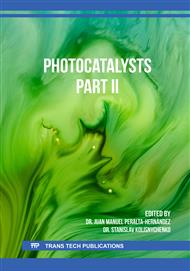[1]
C.M. Wu, S. Naseem, M.H. Chou, J.H. Wang, Y.Q. Jian, Recent advances in tungsten-oxide-based materials and their applications, Front. Mater, 6 (2019) 1-17.
DOI: 10.3389/fmats.2019.00049
Google Scholar
[2]
A. Gasparotto, G. Carraro, C. Maccato, C. Sada, J. Balbuena, M. Cruz-Yusta, L. Sanchez, N. Vodisek, U.L. Stangarde, D. Barreca, WO3-decorated ZnO nanostructures for light-activated applications, CrystEngComm, 20 (2018) 1282-1290.
DOI: 10.1039/c7ce02148h
Google Scholar
[3]
S.H. Li, Z.R. Yao, J.X. Zhou, R. Zhang, H. Shen, Fabrication and characterization of WO3 thin films on silicon surface by thermal evaporation, Mater. Lett., 195 (2017) 213-216.
DOI: 10.1016/j.matlet.2017.02.078
Google Scholar
[4]
P.F. Zhou, Y.B. Shen, S.K. Zhao, G.D. Li, Y.Y. Yin, R. Lu, S.L. Gao, C. Han, D.Z. Wei, NO2 sensing properties of WO3 porous films with honeycomb structure, J. Alloys Compd., 789 (2019) 129-138.
DOI: 10.1016/j.jallcom.2019.03.038
Google Scholar
[5]
Y. Liang, Y. Yang, C.W. Zou, K. Xu, X.F. Luo, T. Luo, J.Y. Li, Q. Yang, P.Y. Shi, C.L. Yuan, 2D ultra-thin WO3 nanosheets with dominant {002} crystal facets for high-performance xylene sensing and methyl orange photocatalytic degradation, J. Alloys Compd., 783 (2019) 848-854.
DOI: 10.1016/j.jallcom.2018.12.384
Google Scholar
[6]
A.C. Anithaa, K. Asokan, C. Sekar, Low energy nitrogen ion beam implanted tungsten trioxide thin films modified indium tin oxide electrode based acetylcholine sensor, J. Taiwan Inst. Chem. Eng., 84 (2018) 11-18.
DOI: 10.1016/j.jtice.2018.01.001
Google Scholar
[7]
Y.M. Hunge, A.A. Yadav, M.A. Mahadik, V.L. Mathe, C.H. Bhosale, A highly efficient visible-light responsive sprayed WO3/FTO photoanode for photoelectrocatalytic degradation of brilliant blue, J. Taiwan Inst. Chem. Eng., 85 (2018) 273-281.
DOI: 10.1016/j.jtice.2018.01.048
Google Scholar
[8]
M.L. Luna, M.A. Alvarez-Amparan, L. Cedeno-Caero, Performance of WOx-VOx based catalysts for ODS of dibenzothiophene compounds, J. Taiwan Inst. Chem. Eng., 95 (2019) 175-184.
DOI: 10.1016/j.jtice.2018.06.010
Google Scholar
[9]
C.S. Prajapati, N. Bhat, ppb level detection of NO2 using a WO3 thin film-based sensor: material optimization, device fabrication and packaging, RSC Adv., 8 (2018) 6590-6599.
DOI: 10.1039/c7ra13659e
Google Scholar
[10]
Y. Xiong, Z.Y. Zhu, T.C. Guo, H. Li, Q.Z. Xue, Synthesis of nanowire bundle-like WO3-W18O49 heterostructures for highly sensitive NH3 sensor application, J. Hazard. Mater., 353 (2018) 290-299.
DOI: 10.1016/j.jhazmat.2018.04.020
Google Scholar
[11]
D.P. Xue, Z.Y. Zhang, Au-sensitized WO3 nanoparticles synthesized and their enhanced acetone sensing properties, Funct. Mater. Lett., 11 (2018).
DOI: 10.1142/s1793604718500716
Google Scholar
[12]
H. Liu, H.L. Zhou, H.D. Li, X.T. Liu, C.J. Ren, Y.C. Liu, W.J. Li, M. Zhang, Fabrication of Bi2S3@Bi2WO6/WO3 ternary photocatalyst with enhanced photocatalytic performance: synergistic effect of Z-scheme/traditional heterojunction and oxygen vacancy, J. Taiwan Inst. Chem. Eng., 95 (2019) 94-102.
DOI: 10.1016/j.jtice.2018.10.003
Google Scholar
[13]
Q.W. Cao, Y.F. Zheng, X.C. Song, Enhanced visible-light-driven photocatalytic degradation of RhB by AgIO3/WO3 composites, J. Taiwan Inst. Chem. Eng., 70 (2017) 359-365.
DOI: 10.1016/j.jtice.2016.10.030
Google Scholar
[14]
P. Wang, L. Yang, B. Dai, Z. Yang, S. Guo, J. Zhu, Nanoplate-like tungsten trioxide (hydrate) films prepared by crystal-seed-assisted hydrothermal reaction, Int. J. Mod. Phys. B, 31 (2017).
DOI: 10.1142/s0217979217440726
Google Scholar
[15]
Y.Z. Xu, W. Zeng, Y.Q. Li, A novel seawave-like hierarchical WO3 nanocomposite and its ammonia gas properties, Mater. Lett., 248 (2019) 86-88.
DOI: 10.1016/j.matlet.2019.04.010
Google Scholar
[16]
Y.Q. Rong, X.F. Yang, W.D. Zhang, Y.X. Yu, Porous ultrathin WO3 nanoflake arrays as highly efficient photoanode for water splitting, Mater. Lett., 246 (2019) 161-164.
DOI: 10.1016/j.matlet.2019.03.044
Google Scholar
[17]
H.C. Ji, W. Zeng, Y.Z. Xu, Y.Q. Li, Nanosheet-assembled hierarchical WO3 flower-like nanostructures: Hydrothermal synthesis and NH3 sensing properties, Mater. Lett., 250 (2019) 155-158.
DOI: 10.1016/j.matlet.2019.05.023
Google Scholar
[18]
J. Yang, J.D. Xiao, H.B. Cao, Z. Guo, J. Rabeah, A. Bruckner, Y.B. Xie, The role of ozone and influence of band structure in WO3 photocatalysis and ozone integrated process for pharmaceutical wastewater treatment, J. Hazard. Mater., 360 (2018) 481-489.
DOI: 10.1016/j.jhazmat.2018.08.033
Google Scholar
[19]
M.B. Tahir, G. Nabi, M. Rafique, N.R. Khalid, Nanostructured-based WO3 photocatalysts: recent development, activity enhancement, perspectives and applications for wastewater treatment, International Journal of Environmental Science and Technology, 14 (2017) 2519-2542.
DOI: 10.1007/s13762-017-1394-z
Google Scholar
[20]
P.Y. Dong, G.H. Hou, X.U. Xi, R. Shao, F. Dong, WO3-based photocatalysts: morphology control, activity enhancement and multifunctional applications, Environ. Sci.-Nano, 4 (2017) 539-557.
DOI: 10.1039/c6en00478d
Google Scholar
[21]
J.A. Darr, J.Y. Zhang, N.M. Makwana, X.L. Weng, Continuous Hydrothermal Synthesis of Inorganic Nanoparticles: Applications and Future Directions, Chem. Rev., 117 (2017) 11125-11238.
DOI: 10.1021/acs.chemrev.6b00417
Google Scholar
[22]
W.D. Shi, S.Y. Song, H.J. Zhang, Hydrothermal synthetic strategies of inorganic semiconducting nanostructures, Chem. Soc. Rev., 42 (2013) 5714-5743.
DOI: 10.1039/c3cs60012b
Google Scholar
[23]
B.L. Cushing, V.L. Kolesnichenko, C.J. O'Connor, Recent advances in the liquid-phase syntheses of inorganic nanoparticles, Chem. Rev., 104 (2004) 3893-3946.
DOI: 10.1021/cr030027b
Google Scholar
[24]
M. Yoshimura, K. Byrappa, Hydrothermal processing of materials: past, present and future, J. Mater. Sci., 43 (2008) 2085-2103.
DOI: 10.1007/s10853-007-1853-x
Google Scholar
[25]
D. Ariyanti, J.Z. Dong, W. Gao, Hierarchical structures of coated TiO2 nanoribbons with photodegradation and sedimentation properties, Int. J. Mod. Phys. B, 33 (2019)1940022.
DOI: 10.1142/s0217979219400228
Google Scholar
[26]
D.M. Zhang, L.J. Pan, C.W. Li, L.C. Xia, Y.P. Hu, Y.Z. Bin, W. Gao, Fabrication of flower-like TiO2 on Bucky paper with enhanced photocatalytic activity, Int. J. Mod. Phys. B, 33 (2019).
DOI: 10.1142/s0217979219500176
Google Scholar
[27]
B. Ahmed, S. Kumar, A.K. Ojha, P. Donfack, A. Materny, Facile and controlled synthesis of aligned WO3 nanorods and nanosheets as an efficient photocatalyst material, Spectrochimica Acta Part A: Molecular and Biomolecular Spectroscopy, 175 (2017) 250-261.
DOI: 10.1016/j.saa.2016.11.044
Google Scholar




